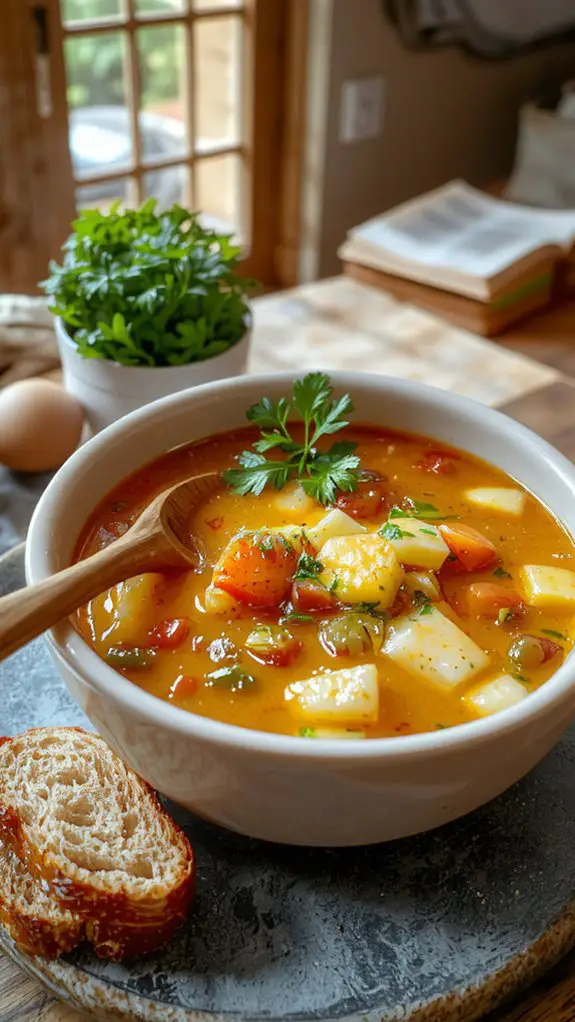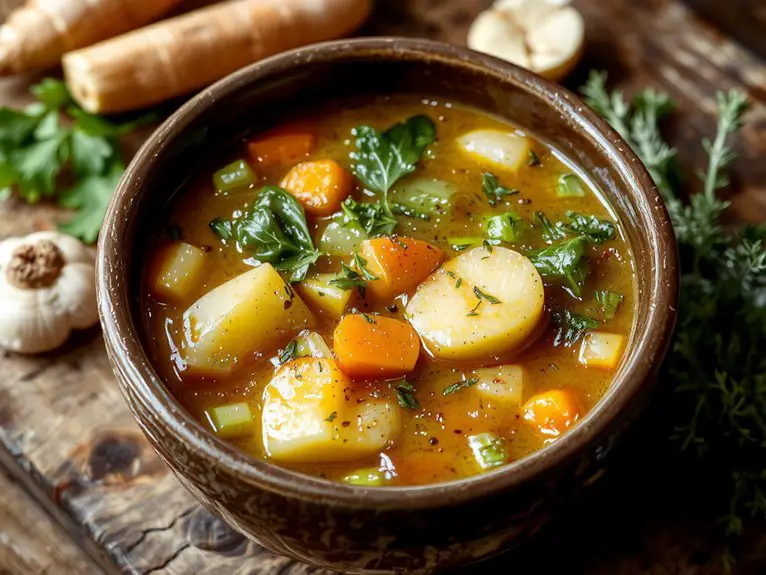I’ve spent years perfecting my vegetable soup recipe, and I’m convinced it’s the best. It starts with a simple base of onions, garlic, and celery, slowly cooked to bring out their sweetness. From there, it’s all about layering flavors with fresh vegetables, herbs, and a rich broth. The result is a comforting bowl that’s both nutritious and deeply satisfying. But the real secret lies in the timing—wait until you see when to add the greens.
Recipe
This isn’t just any vegetable soup—it’s the kind of cozy, soul-warming dish that turns a dreary day into something special. Packed with vibrant veggies, aromatic herbs, and a broth that’s rich but not overwhelming, it’s a recipe I’ve perfected over years of chilly evenings and lazy Sundays.
The secret? Simplicity. Fresh carrots, celery, and kale shine alongside a hint of garlic and thyme, creating a harmony of flavors that feels both nourishing and indulgent. It’s the kind of soup that makes you want to curl up on the couch with a bowl and a good book.
And the best part? It’s ridiculously easy to make, even if you’re not a soup pro. Trust me, once you try this, it’ll become a staple in your kitchen. Let’s get cooking!
Ingredients
Start with a flavorful base by sautéing aromatics like onions, garlic, and celery—they’re the backbone of any great soup. Fresh is always best, but frozen or jarred can work in a pinch.
Next, load up on hearty vegetables like carrots, potatoes, and zucchini for texture and depth. Don’t forget a can of diced tomatoes for a tangy, umami kick.
Fresh herbs like thyme or parsley add a bright finish, but dried herbs can substitute if needed. Finally, a splash of olive oil and a good-quality vegetable stock tie it all together. Here’s what you’ll need:
- Aromatics:
- 1 large onion, diced
- 3 garlic cloves, minced
- 2 celery stalks, chopped (optional but highly recommended)
- Hearty Vegetables:
- 2 large carrots, peeled and sliced
- 2 medium potatoes, peeled and cubed
- 1 zucchini, diced (swap for squash if you prefer)
- Flavor Boosters:
- 1 can (14 oz) diced tomatoes (fire-roasted for extra depth)
- 2 tablespoons olive oil (for sautéing)
- 4 cups vegetable stock (homemade or low-sodium store-bought)
- Herbs & Seasoning:
- 1 teaspoon dried thyme (or 1 tablespoon fresh)
- 1 bay leaf
- Salt and pepper to taste
Pro Tips:
- Use a mix of colorful vegetables for visual appeal and varied nutrients.
- If you’re out of vegetable stock, water with a splash of soy sauce or miso paste works as a quick substitute.
- For extra richness, add a Parmesan rind while simmering—it’s a game-changer!
Little Wins:
– Garnish with fresh parsley or a drizzle of olive oil for a restaurant-worthy finish.
How to Make the Best Classic Vegetable Soup Recipe

- Prepare your veggies. Chop all vegetables into uniform sizes to guarantee even cooking. This prevents some pieces from being overcooked while others remain undercooked.
- Sauté aromatics. Heat a large pot over medium heat, add oil, then sauté onions, garlic, and celery until softened and fragrant. This builds a flavorful base for the soup.
Pro tip: Don’t rush this step—caramelizing the onions slightly adds depth.
- Add hearty vegetables. Toss in carrots, potatoes, and any other hearty veggies, stirring to coat them with the aromatics. Let them cook for a few minutes to enhance their flavor.
- Pour in broth. Add vegetable or chicken broth to the pot, making certain it covers the vegetables.
Watch out: Avoid adding too much broth, as it can dilute the flavor.
– Season the soup. Add salt, pepper, and herbs like thyme or bay leaves.
Flexibility: Adjust seasoning later if needed, but starting with a base guarantees the flavors meld well.
– Simmer gently. Bring the soup to a boil, then reduce the heat to a simmer. Let it cook for 20-30 minutes until the vegetables are tender but not mushy.
Visual cue: The broth should be slightly thickened, and the veggies should be soft yet hold their shape.
- Add delicate greens. Stir in leafy greens like spinach or kale during the last 5 minutes of cooking. This keeps them vibrant and prevents them from becoming overcooked.
- Taste and adjust. Before serving, taste the soup and adjust the seasoning if needed.
Pro tip: A splash of lemon juice or vinegar can brighten the flavors.
– Serve and enjoy. Ladle the soup into bowls, and optionally top with fresh herbs, a drizzle of olive oil, or a sprinkle of grated Parmesan.
Flexibility: This soup can be stored in the fridge for up to 3 days or frozen for longer storage.
Nutrition
Homemade vegetable soup is a nutritious and hearty dish packed with essential vitamins and minerals. Here’s the nutritional breakdown per serving:
| Nutrient | Amount per Serving |
|---|---|
| Calories | 150 kcal |
| Total Fat | 3 g |
| Saturated Fat | 0.5 g |
| Cholesterol | 0 mg |
| Sodium | 400 mg |
| Total Carbs | 25 g |
| Dietary Fiber | 6 g |
| Sugars | 8 g |
| Protein | 5 g |
| Vitamin A | 120% DV |
| Vitamin C | 60% DV |
| Calcium | 6% DV |
| Iron | 10% DV |
Chef Tips
When making homemade vegetable soup, I always recommend starting with fresh, seasonal vegetables for the best flavor and texture. Don’t skip sautéing onions, carrots, and celery first—it builds depth.
Use a mix of broth and water for balance. Add delicate greens like spinach at the end to avoid overcooking.
Taste and adjust seasoning before serving. Freeze leftovers in portions for quick meals later.






